Kokufu Bonsai Ten, Part I
("National Bonsai Exhibition")
 |
|
Koku
Fu Bon
Sai Ten |
Compiled by Robert J. Baran, with William N. Valavanis
This Page Last Updated: February 23, 2025
|
This now eight-day February national exhibit of bonsai is the largest and most prestigious of all bonsai shows
worldwide. The Nippon Bonsai Association
(NBA), the official sponsor of the event, has worked diligently over many years to insure that only the finest bonsai
in Japan are displayed in the Tokyo Metropolitan Art Museum in Ueno Park, Tokyo. To win one of the several
prizes or sho awarded greatly enhances the career of the stylist and honors the owner of the outstanding
tree. In a given year there may be anywhere from one to five of the prizes awarded. However, the
Kokufu-sho is not given if there is not a worthy tree. Once a tree does win the prize, it is never
again eligible for another Kokufu-sho but it still can be entered additional times for display only. The Kokufu-sho is a "trophy" as a simple shikishi board, used for paintings. It is gold-colored with kanji characters which read "Kokufu Prize." A monetary prize is not attached, but there is a certificate which often can then be hung in the owner's home. The shikishi board is often displayed with the bonsai when exhibited in other shows. It is common for the top Kokufu Prize bonsai from the February exhibition to be displayed along with the board at the Taikan exhibition the following November. (The Taikan Ten is the "Grand View Exhibit" held in Kyoto. This outstanding, four-day national exhibit of bonsai is the largest and best of the late season shows, first held in 1981. This is another of the exhibits that is held for hobbyists, although many of the better trees have been styled and maintained by bonsai professionals. The Meifu-ten, held in Nagoya in January, is the second oldest and third largest exhibition in Japan.) The Kokufu Ten is set up on Friday and Saturday. The awards are given to the bonsai after the show is set up a few days before the opening, without ceremony. The show does not open until Tuesday. The Kokufu Bonsai Exhibition is organized and run by the Nippon Bonsai Association, but sponsored by the City of Tokyo, Ministry of Education and NHK TV. |

| |||||||
|
The small silver plaque on top is designated for an Important Bonsai Masterpiece. The lower gold plaque is for
the Kokufu Prize. Important Bonsai Masterpieces or kicho
bonsai have been designated by the Nippon Bonsai Association as special masterpieces because they have been recognized
as being "cultural assets of the entire nation," such as those with unique forms and species, those that are
academically valuable, those that have legends and traditions, and those that have high value in Japanese history.
Once a year, new trees are entered for evaluation by the owners of the bonsai. The system for registering
kicho bonsai was established in 1980 by the NBA and as of April 2023, 1,263 bonsai have been registered.
They can be identified by small metal tags hanging on a branch or a silver colored metal plaque. These are often
displayed on or next to a bonsai when on display. These trees are automatically accepted for display in the Kokufu
Bonsai Exhibition.
|
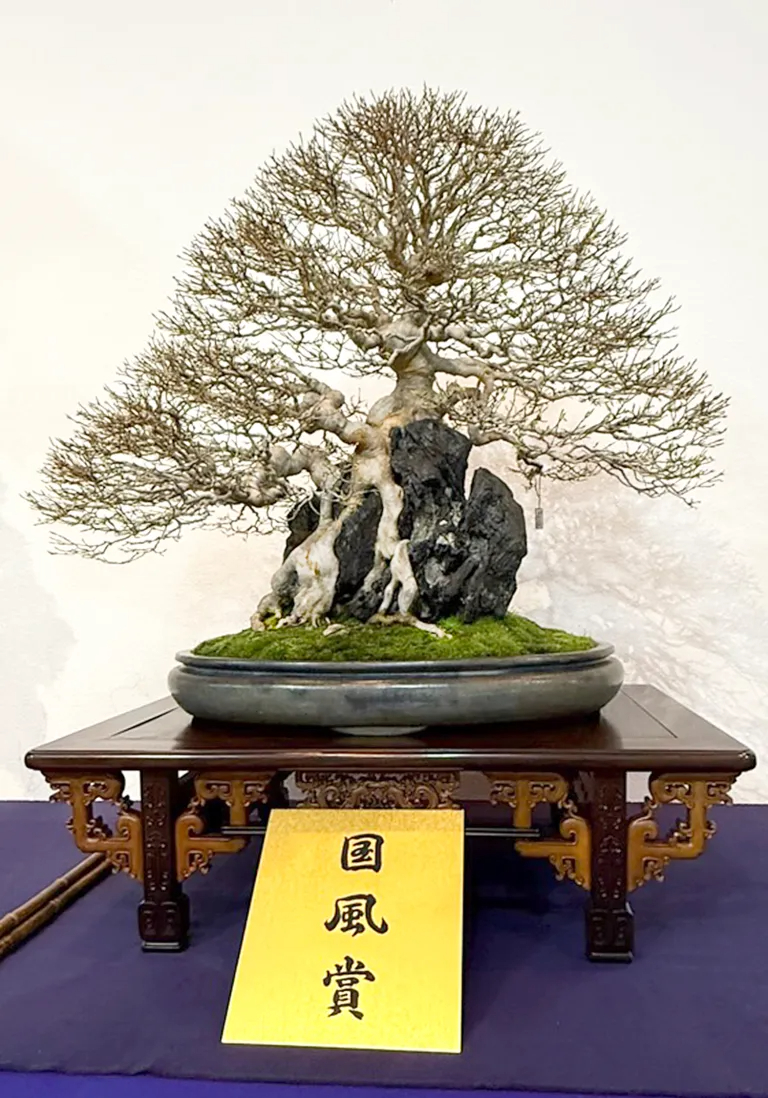
|

| |
|
Kokufu Prize, 2025, Part 1: Trident maple (Acer buergerianum), root-over-rock |
Kokufu Prize, 2025, Part 1: Shimpaku Juniper (Juniperus chinensis var. shimpaku) |
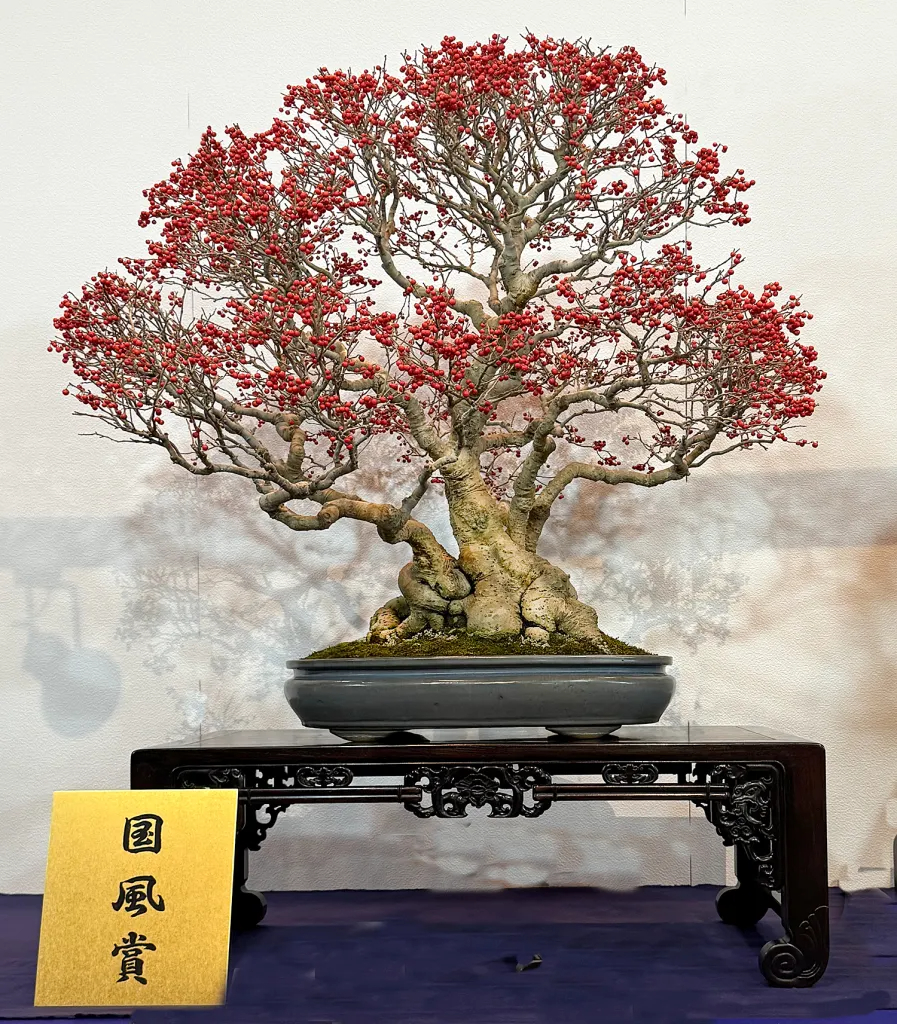
|
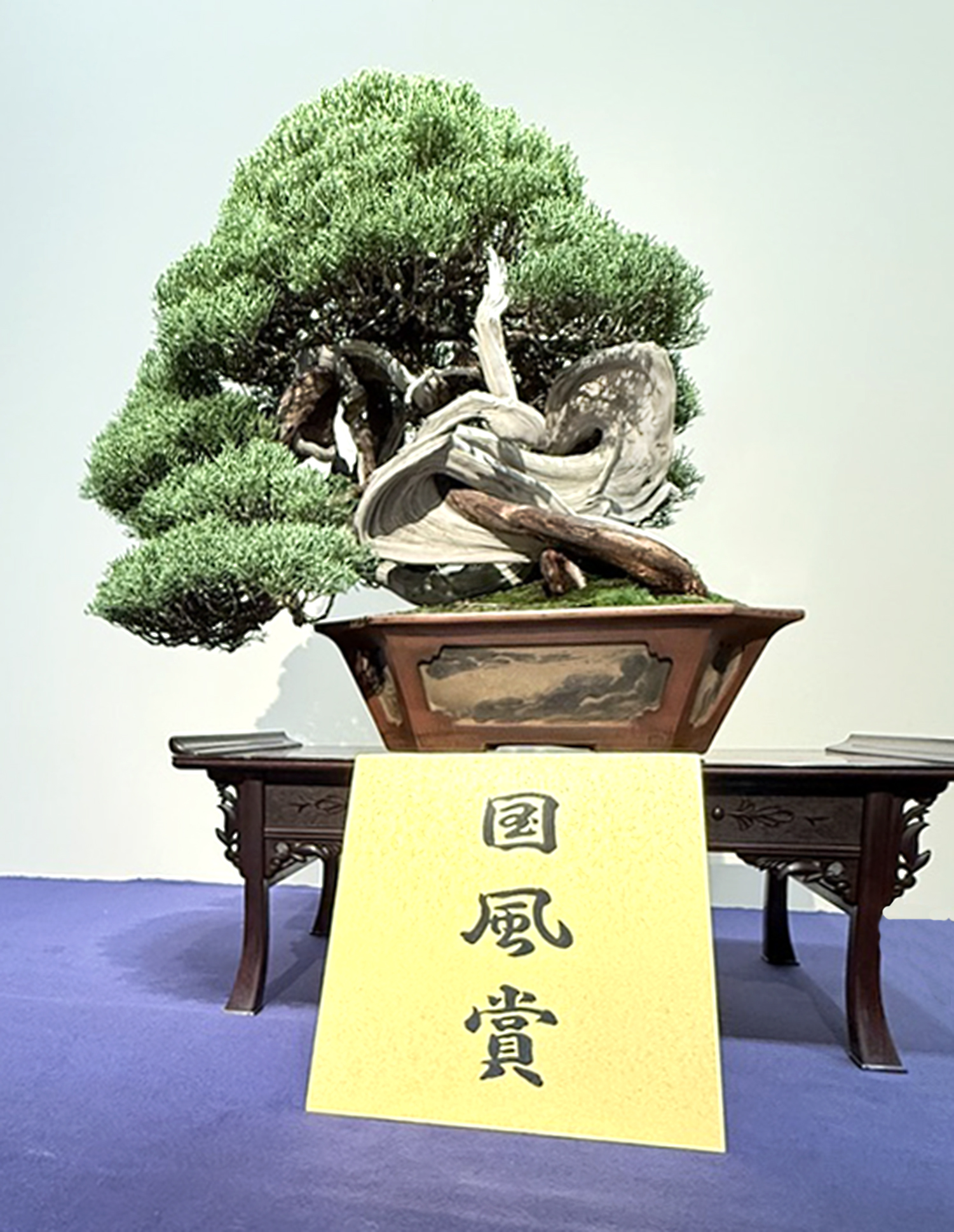
| |
|
Kokufu Prize, 2025, Part 1: Finetooth Holly (Ilex serrata) |
Kokufu Prize, 2025, Part 1: Juniper (Juniperus sp.) |
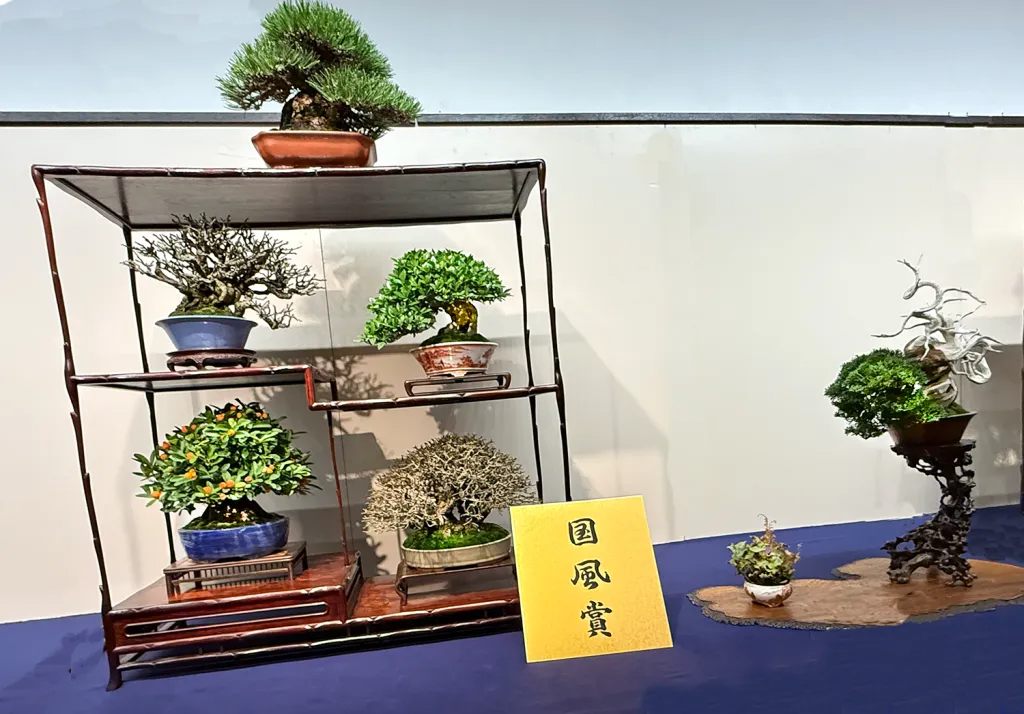
| |
|
Kokufu Prize, 2025, Part 1: Shohin Bonsai Composition |
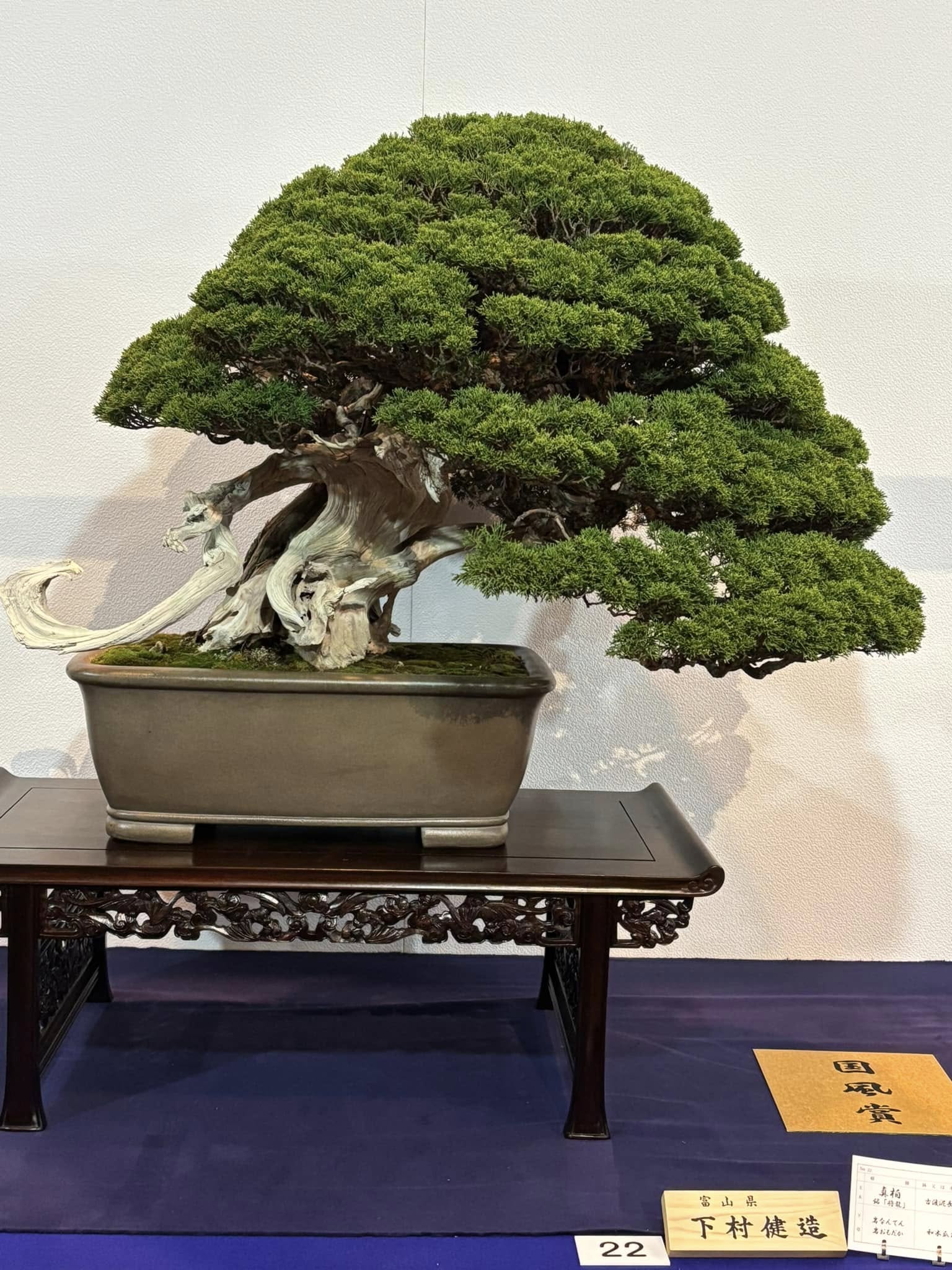
|
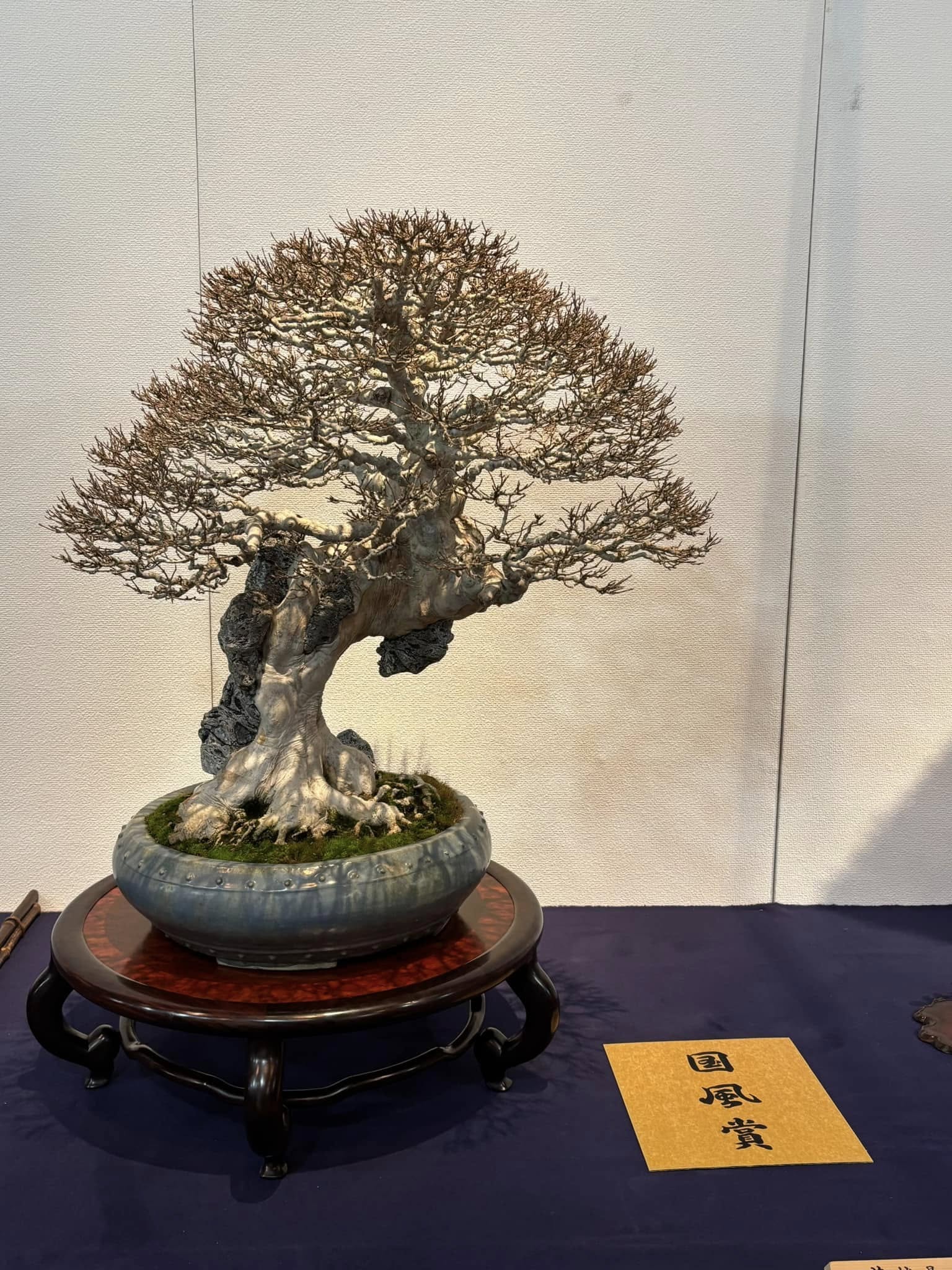
| |
|
Kokufu Prize, 2025, Part 2: Shimpaku Juniper (Juniperus chinensis var. shimpaku) |
Kokufu Prize, 2025, Part 2: Trident maple (Acer buergerianum), root-on-rock |
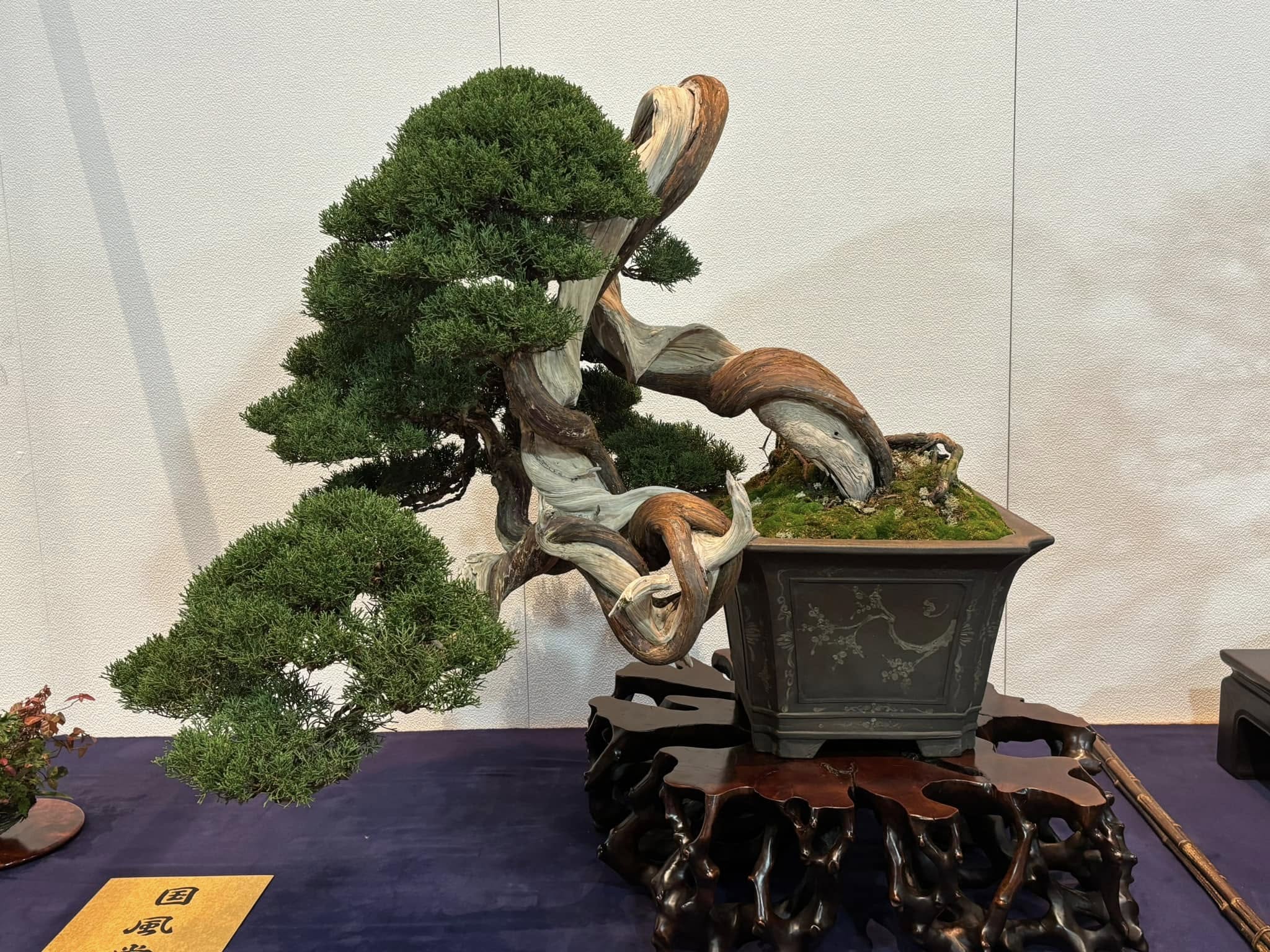
| |
|
Kokufu Prize, 2025, Part 2: Shimpaku Juniper (Juniperus chinensis var. shimpaku) |
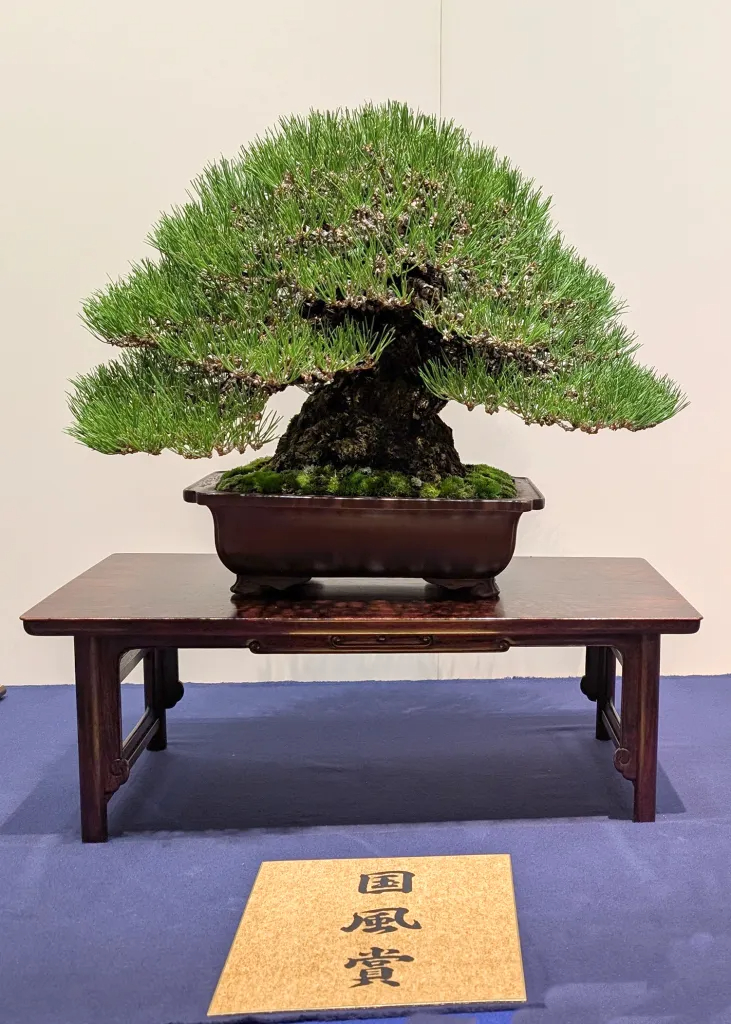
| |
|
Kokufu Prize, 2025, Part 2: Pine (Pinus sp.) |
|
For Part 1 of 2025 it seemed as though there was a larger number of junipers and pines compared
with deciduous species. Like in past exhibitions, there were fewer rock plantings and
forests but more literati style bonsai were displayed. The Japanese flowering apricot
bonsai were well represented, and in blossom too. There was a good representation of
Zuisho Japanese five-needle pine bonsai. In part due to the good weather, over 1,000
visitors saw the show every day. Five Kokufu Prizes were awarded to outstanding bonsai. Unione Bonsaisti Italiani (UBI) member Giovanni Americano won a Kokufu Prize with his Acer Buergerianum bonsai root-over-rock. There were 13 Important Bonsai (kicho) shown. As always all the bonsai were beautiful and simply displayed to allow their beauty to shine. Four Kokufu Prizes were given in the second part. |
|
Kokufu-Ten 2025 All Exhibitied Bonsai - Exhibition Part 1
|
| A 32-minute-long Video of the 99th
Kokufu Ten, 2025, Part I by Bonsaifly |
|
In Part II of the 2024 98th Kokufu Ten there were 12 bonsai displayed by owners from foreign countries: Germany,
Sri Lanka, Italy, Spain, China and the U.S. (Of course, these were Japanese-trained bonsai and we doubt if
the owners ever watered these plants.) The 61st Exhibition of Suiseki Masterpieces was held on February 14-17, but in a different gallery on the 2nd floor. This is the main suiseki exhibition of the Nippon Suiseki Association. It has replaced the ten previous exhibitions held in the past. Kunio Kobayashi and Seiji Morimae headed up the NSA. There were 74 general exhibits, 28 special entries, 20 Alcove Displays, and 18 Foreign Entries (Italy, Germany, Philippines, Viet Nam, Thailand, Australia, France, Denmark, and USA). The NSA made a major change to its exhibition program involving the annual Meihin-ten and Japan Suiseki Exhibitions. Beginning in 2024, the Meihen-ten Suiseki Masterpiece exhibition has shifted from its Meiji Shrine venue to the Tokyo Metropolitan Art Museum. The name Japan Suiseki Exhibition is being dropped and replaced with the Exhibition of Suiseki Masterpieces. Instead of organizing two major viewing stone exhibitions each year in Tokyo, the association is reducing that to a single exhibition held in February. This major change may be due to the continued shrinking of the number of suiseki collectors in Japan combined with the limited resources of the NSA to stage two exhibits and publish two exhibit catalogs each year. The first exhibition of Japanese Suiseki Masterpieces (the Meihin-ten) was held in 1961 and continued each year until 2012 when the NSA held the first exhibition in the Art Museum. This venue attracts more visitors than the Meiji Shrine site, and the combination of two related exhibits, bonsai and stones, make it more attractive to foreign visitors. This proved successful as more foreign exhibitors participated in the Japan Suiseki Exhibition. |
|
98th Kokufu Bonsai Exhibition in Tokyo, Part 2, 2024
|
| An Hour-Nine-minute-long Video of the 98th
Kokufu Ten, 2024 by Bonsai Channel |
|
98th Kokufu Bonsai Exhibition in Tokyo, Part 1, 2024
|
| An Hour-long Video of the 98th
Kokufu Ten, 2024 by Gak Bonsai |
|
A Year Earlier's Development of the Tree Shown at the 2:05 mark in the Above
|
| A Ten Minute Video Transformation of Juniperus chinensis by
Masahiko Kimura THE first award winning tree in Part 1! by Kindai Bonsai |
|
Preparing Trees for the Risshun Bonsai Grand Market held in conjunction with Kokufu
|
| A Twenty-three Minute Video Preparing Trees for the Risshun Bonsai Grand Market by WABI Channel |
|
97th Kokufu Bonsai Exhibition 2023 Part 2
|
| A Thirty-four Minute Video from Part 2 of the 97th
Kokufu Ten, 2023 by Rome Tokyo one way |
|
97th Kokufu Bonsai Exhibition 2023 Part 1
|
| An Eleven-and-a-half Minute Video from Part 1 of the 97th
Kokufu Ten, 2023 by Bonsai_Fukushimaen |
|
Risshun Bonsai Fair 2023
|
| A Forty-one-and-a-half Minute Video of Risshun Bonsai Oichi by bonsaiQ |
|
The 2023 Kokufu Bonsai Exhibit was forecast to probably be full of foreigner visitors because they had not been
allowed to enter Japan for almost three years. The aisles appeared to be wider, probably because of COVID-19
restrictions. Everyone entering the Museum had to wear a face mask and sanitized their hands. Non-Japanese
exhibitors were significant in Part I: 2 USA, 4 Italy, 2 Germany, 1 Thailand, 1 England, and 1 China.
Part II had 1 each from Italy, Thailand, and Sri Lanka. The 10th Japan Suiseki Exhibition was held at the Tokyo Metropolitan Art Museum in Ueno Park, Tokyo, on February 14-18, 2023. Kunio Kobayashi and Seiji Morimae head up the Nippon Suiseki Association. The suiseki exhibition is held in a 2nd floor gallery which is carpet covered. No water is allowed in this exhibition room, which is why water is not included in the water basin displays of suiseki, the traditional and formal way of appreciating suiseki. Also, that is why there are no accessory plantings displayed with the stones. There were 8 Featured Entries, 32 Alcove Displays, 1 Guest Entry from the Hosokawa School of Bonseki titled "Surging Sea," 78 General Exhibits, 22 International General Exhibits from the United States, Italy, Germany, Switzerland, Vietnam, Australia, and Taiwan. |
|
Set-up of 96th Kokufu Bonsai Exhibition 2022
|
| A Six-and-a-third Minute Video of Set-up of the 96th
Kokufu Ten, 2022 by Gak Bonsai |
|
96th Kokufu Bonsai Exhibition 2022 Part 1
|
| A Ten Minute Thirteen Second Video from Part 1 of the 96th
Kokufu Ten, 2022 by Bonsai_Fukushimaen |
|
96th Kokufu Bonsai Exhibition 2022 Part 2
|
| A Fifty Minute Forty-five Second Video from Part 2 of the 96th
Kokufu Ten, 2022 by Bonsai channel |
|
95th Kokufu Bonsai Exhibition 2021 Part 1
|
| A Thirty-one-and-a-half-Minute Video from Part 1 of the 95th
Kokufu Ten, 2021 by Makiko Koba |
|
95th Kokufu Bonsai Exhibition 2021 Part 2
|
| Nearly Fifty-five Minute Video from Part 2 of the 95th
Kokufu Ten, 2021 by Makiko Koba |
|
95th Kokufu Bonsai Exhibition 2021 Part 1
|
| A Fourteen Minute Video from Part 1 of the 95th
Kokufu Ten, 2021 by Bonsai_Fukushimaen |
|
Kokufu Bonsai Exhibition -- Risshun Bonsai Oichi
|
| A nearly Two Minute Video of Risshun Bonsai Oichi by Kindai Bonsai |
|
94th Kokufu Bonsai Exhibition 2020 Part 1
|
| An Eleven-and-a-half Minute Video from Part 1 of the 94th
Kokufu Ten, 2020 by Bonsai_Fukushimaen |
|
94th Kokufu Bonsai Exhibition 2020 Part 2
|
| A nearly Fifteen Minute Video from Part 2 of the 94th
Kokufu Ten, 2020 by Bonsai_Fukushimaen |
|
Part 1 of the 2020 Kokufu Bonsai Exhibition had 151 exhibits. These included 106 large-size, 39
medium-size, and seven shohin compositions. There were seven special exhibits including a Suiseki
special exhibit, plus a juniper, a Pinus parviflora, and a deep large ceramic pot ("owari sapphire-colored
decorated suiban") from the Imperial Household. Two of the show's bonsai compositions did include a suiseki.
Mr. Toru Suzuki was the Chairperson of the Kokufu Exhibition. Part 2 of the 2020 Kokufu Bonsai Exhibition also had 151 exhibits. These included 106 large-size, 39 medium-size, and seven shohin compositions. One of the seven special displays in this part was a Deodor cedar, Cedrus deodara, a common garden tree extremely rare to see trained for bonsai, which was from the famous Keiunan Bonsai Collection of Mr. Tanaka and was once owned by Prime Minister Shigeru Yoshida. There was one Suiseki special exhibit, but four bonsai compositions included a suiseki. Mr. Yukizyuou Nakano (Gyozan) specializes in large unglazed containers, but also hand-makes smaller and glazed pots too. Mrs. Nakano is a talented artist as well and often hand-paints scenes on containers her husband makes. There were 96 large bonsai displayed in the main gallery and 10 were planted in Gyozan containers which equates to 11% of the large bonsai in the main gallery being made by Gyozan. The 7th Japan Suiseki Exhibition was held on February 14-18, again, in the same building as the Kokufu Bonsai Exhibition, but on a different floor. There were seven special entries, 32 alcove displays and a guest entry of a bonseki from the Hosokawa School. Members displayed 89 suiseki in the general entries. The foreign entries included suiseki from: Philippines, Italy, Denmark, Germany, Vietnam, Australia, China and the United States. There were 21 suiseki in this category. Starting this year, the organization would be having a special exhibit featuring 22 suiseki from famous rivers which had produced excellent suiseki. In total, there were 171 suiseki and one bonseki in this exhibition. |
|
Part 1 of the 2019 Kokufu Bonsai Exhibition had 151 exhibits. These included 97 large-size, 47 medium-size,
and seven shohin compositions. Fewer trees were displayed this year. This was clearly evident
with the removal of one entire row against a far wall and hanging large photos of blossoming satsuki azalea bonsai,
with the cultivars in English too. This served two purposes: making wider aisles and adding color to a
relatively winter bonsai appearance. The ten fewer bonsai was well compensated by the high quality
specimens. Two other changes could be noticed: The two special exhibits -- one from the
Imperial Bonsai Collection -- were moved and, also, the small room
with shohin and medium-size bonsai had been rearranged. Part 2 of the 2019 Kokufu Bonsai Exhibition also had 151 exhibits. These included 108 large-size, 36 medium-size, and seven shohin compositions. The Kokufu Award was given to five trees. The Trident Maple which won an Award in this Part was under the care of Shinji Suzuki. One of his client's bonsai also won a Kokufu Award in Part 1. Officials estimate that approximately 1,200 people have visited the exhibition daily. |
|
The 6th Japan Suiseki Exhibition was held at the Tokyo Metropolitan Art Museum in Ueno Park, Tokyo, on
February 14-17, 2019. This was the same venue as the Kokufu Bonsai Exhibition, but in a different gallery
on the 2nd floor. Seiji Morimae was able to get a five year contract to hold this prestigious exhibition
of stones, and it looked like it will likely continue with his and Kunio Kobayashi's leadership of the Nippon
Suiseki Association. Part 1 of the 2018 Kokufu Bonsai Exhibition had 179 exhibits with a total of more than 221 individual bonsai specimens. These included 116 large-size, 41 medium-size, and four shohin compositions with 23 individual trees. It is interesting to note the current way of creating shohin bonsai compositions: usually a box stand is used with an evergreen tree on the top. It faces one way or the other, but it always leads your eye to a side bonsai lower down, often a cascade style evergreen. This style of display is often seen as boring or static, however, by Westerners. Part 2 of the 2018 Kokufu Bonsai Exhibition had 161 exhibits with a total of about 224 individual bonsai specimens. These included 114 large-size, 43 medium-size, and four shohin compositions with 24 individual trees. Congratulations go to Shinji Suzuki whose clients won three out of the four 2018 Kokufu Prize winners. He is responsible for displaying and preparing the bonsai for his clients, but not necessarily for their creation. Masterpiece bonsai of this quality take many decades to develop and are bought and sold frequently. Each time they change hands they usually improve in quality. It is not uncommon to see a famous bonsai in different gardens every year. Masahiko Kimura had worked on 55 pieces that were on display, which is down from over 70 a few years ago. Still, that's a staggering number to be proud of considering about 445 bonsai were displayed this year. |

|
|
For the past few years there have been new backgrounds in the main gallery where most of the larger-size bonsai
are displayed. The old backgrounds were beige, smooth and shiny and are still being used in the other
three galleries. The new ones are white with a slight texture like burlap and a bit reflective, making
the entire room bright white and showing quite a difference and improvement from the past exhibitions.
The trees also photograph better. The LED lighting is a bit harsh on many trees and some are nearly
impossible to photograph. But, it is important to remember that this exhibition is set up to display the
beauty of the bonsai, not to provide a venue for people to photograph the trees. Simultaneously with the 92nd Kokufu Ten was the 5th Nippon Suiseki Exhibition, February 14-17, 2018, in the Tokyo Metropolitan Art Museum on the 4th floor. There were 82 General Exhibits, 6 Special Exhibits, 32 Tokonoma Displays, 1 Guest Entry, 17 Foreign Displays, and 11 Accessory Exhibits on display from Japan, the Philippines, Italy, Malaysia, England, Czech Republic, Spain, Denmark, and the United States. The previous year, the 4th Nippon Suiseki Exhibition was held simultaneously with the 91st Kokufu Ten, from February 10-14, 2017. Over 100 fine quality suiseki were on display from Japan and around the world. |
|
93rd Kokufu Ten, 2019
|
| A Thirty-one+ Minute Video from Part I of the 93rd Kokufu Ten, 2019 by Rome Tokyo one way |
|
93rd Kokufu Ten, 2019
|
| A Six-and-a-quarter Minute Video from 93rd Kokufu Ten, 2019 by Andy Jordan |
|
92nd Kokufu Ten, 2018
|
| A Nine+ Minute Video from 92nd Kokufu Ten, 2018 in Portuguese by Felipe Dallorto |
|
91st Kokufu Ten, 2017
|
| A Five-and-a-half Minute Video from 91st Kokufu Ten, 2017 and the Green Club by NHK and Japan Bonsai Association posted on Facebook |
|
91st Kokufu Ten, 2017
|
| A Fourteen Minute Video from 91st Kokufu Ten, 2017 in French with many awesome close-ups by Monsieur Bonsaï, Part I |
|
91st Kokufu Ten, 2017
|
| A Nine-and-a-half Minute Video from 91st Kokufu Ten, 2017 of larger trees by Andy Jordan, Part I |
|
Part 1 of the 2017 Kokufu Bonsai Exhibition had 179 exhibits. These included five spectacular shohin
compositions and each of these had at least five trees. It is interesting to note the current way of
creating shohin bonsai compositions: usually a box stand is used with an evergreen tree on the top.
It faces one way or the other, but it always leads your eye to a side bonsai lower down, often a cascade style
evergreen. This style of display is often seen as boring or static, however, by Westerners. Additionally there were 44 medium-size compositions, each having a minimum of two main bonsai, plus companion plantings. That makes a total of more than 300 individual bonsai specimens in Part 1. For Part 2, all of the trees from the first Part 1 were removed, except for the Imperial Bonsai Display and two other special exhibits, and they were replaced by another 179 display areas including 51 medium-size exhibits and six shohin bonsai compositions. Attendance for the 90th Kokufu Ten was estimated at about 20,000 people. Parts 1 and 2 each had 181 display areas; however, there were a great number medium-size bonsai which usually include two or more trees. In Part 2 there were only four shohin bonsai compositions which each had more than five specimens. So there were actually approximately 250 individual bonsai on display. That year, for the first time in modern history, photographs were allowed, but without flash. Visitors had cell phones snapping away, as well as some with larger cameras. (A few years earlier some visitors had complained to the Nippon Bonsai Association that the click of cameras bothered their appreciation of the bonsai.) Beginning with the 60th Kokufu Bonsai Exhibition in 1986, the Nippon Bonsai Association has commemorated every tenth anniversary year by holding the exhibition in two parts. In order to present more bonsai recently also, the events in 2014 and 2015 were scheduled in two parts, each lasting four days with a switch-out day between when all the trees would be changed on Saturday. The first part of 2014's Exhibition (the 88th, Feb. 4 - 7) was composed of 170 displays, including 29 kicho Bonsai (Important Bonsai Masterpieces). These are automatically accepted into the show. After the exhibition was set up a group of judges awarded five coveted National Awards (Kokufu-sho). There were only five shohin bonsai compositions, a mame bonsai composition was not included in this part. There were 46 medium-size three-point exhibits which included a main bonsai, often two, and a companion planting. Considering that each shohin bonsai composition had six main bonsai and a side tree (all very consistent which shows the current taste of display) and most medium size exhibits had two trees nearly 300 individual specimens were shown. Two Americans, Doug Paul and Frank Cucchira, displayed Sargent juniper bonsai. Another exhibitor from Italy also displayed a Sargent juniper bonsai and received one of the five Kokufu-sho awards, the first time for a foreigner. Unlike in previous years, there were pink lights against the bright blue table coverings with the addition of dramatic spot lighting which did not make it easy to photograph the compositions. The 2014 Part 2 was held from Feb. 9 - 12. It also had 170 displays, 26 kicho Bonsai, and 55 medium size bonsai. There were again only 5 shohin bonsai compositions. The judges selected six Kokufu prize bonsai for Part 2. |
|
(As much as 27 centimetres -- 10.6 inches -- of snow was recorded in Tokyo by late Saturday, February 8, 2014,
the heaviest fall in the capital for 45 years, according
to the meteorological agency. The snow storm hit the capital on the eve of its gubernatorial
election. Observers say the heavy snowfall may have affected voter turnout in the city of 13 million
people. The storm's affect on Kokufu Ten attendance was not reported.) (History was made on February 9-13, 2014 when the newly reorganized Nippon Suiseki Exhibition held the first ever suiseki exhibition at the Tokyo Metropolitan Art Museum. Under the leadership of Kunio Kobayashi (Chairman) and Seiji Morimae (Secretary General), the event was held concurrently during Part 2 of the Kokufu Bonsai Exhibition so people could enjoy both arts in one venue (separate floor galleries). This brought a new era to the combination, appreciation and promotion of bonsai and suiseki.) For the 2013 show there were six National Prize winners (see about two-thirds down the page). Also there were seventy Kicho Bonsai displayed. For the 2012 show there were four National Prizes: Japanese black pine, Satsuki Osakazuki, Shimpaku juniper, and a Shishigashira Japanese maple. For the 2011 show there were five National Prizes: Japanese flowering apricot, Sargent's juniper, Ezo spruce, Korean hornbeam, and a Japanese five-needle pine. Forty-five trees were listed as important Bonsai Masterpieces. In comparison, for the first half of the double-show 2006 year, three of he National Prizes were awarded. A Japanese five-needle pine 'Zuisho', a shimpaku juniper (Juniperus chinensis var. 'Sargenti'), and a chojubai (Chaenomeles japonica 'chojubai', dwarf flowering-quince) were most highly esteemed by the panel of sixteen award judges. For the second half, there were five National Prizes awarded: another chojubai dwarf flowering-quince, a Japanese five-needle pine (Pinus pentaphylla), a Chinese quince (Pseudocydonia sinensis), a Needle juniper (Juniperus rigida), and a shohin bonsai display. The bonsai displayed range from large specimens (up to about 120 cm or 48" tall) to the small shohin-sized trees (less than 25 cm or 10" in height). Although taking place in the dead of winter, nothing is forced to bloom or bud early for the show. The Japanese like to see their bonsai in their natural form. Therefore, the foliage of the Japanese yew, cryptomeria and Needle juniper will mostly be in the reddish winter coloring. And all deciduous trees are represented: true, the majority are still intricate silhouettes, but the early bloomers (literally) are covered in festive pastels. Approximately 260 trees are now displayed annually in the Metropolitan Art Museum (Tōkyō Bijutsukan) in Ueno Park in northeastern Tokyo. (For the year 2013 there were 204 displays including only six shohin compositions.) Usually every ten years the show is doubled to about 520 trees. (Since its opening in 1926, the Museum has been very popular among citizens as a venue for public exhibitions by nationally and internationally renowned fine arts organizations. The museum had previously been renovated in 1975.) In 2011 and 2012 the show was moved to the Tokyo Metropolitan Industrial Trade Center, located across the street from the Asakusa Kannon Temple in Asakusa, less than a mile to the east of Ueno, while the Museum was being renovated to make it accessable for the elderly and handicapped. "The exhibition [here] is all in one room, on the 7th floor. It must have been an ordeal to move over 250 bonsai and display tables in elevators all the way up to the 7th floor. Many new sections of backgrounds needed to be purchased in order to use the new venue, very expensive, as is the daily rental for the 7th floor... with its low ceiling. All the bonsai are in one large room [compared to the usual four smaller rooms], no time to sit and think... and study. The number of entries decreased slightly as [some] owners did not want their prize bonsai displayed in the Industrial Trade Center, they preferred the Art Museum." The show was returned to the Art Museum in 2013. During the closure, several new elevators and escalators were installed along with many massive textured concrete walls. There are now three Gallery Rooms. The Kokufu show was previously housed on two basement floors of the Museum. The lowest level contained all the large bonsai, which comprise the majority of displays. The upper floor showcased the shohin and small bonsai. This grouping of trees by size prevented the overpowering of some bonsai by proximity to others. The bonsai were displayed in four rooms which allows one to mentally rest between studying the bonsai. The bonsai exhibition is open to the general public and is always seen by crowds. Over 40,000 visitors annually were viewing the show in the early 1990s. (36,000 braved the heavy snows in 1994.) During the last few years, though, attendance has been as low as around 15,000. Between 30,000 and 35,000 people were expected to view the two-part show in 2006 -- the first part's attendance was estimated to be over 15,000 persons. Approximately 28,000 people visited the 2007 exhibition. In 2010, the attendance was only about 17,000 people, but many foreign groups from Italy, France, Spain, etc. did attend. The admission price is ¥1,000 (currently about 6.70 USD or 6.21 Euro), with a Group Reduction for a party of over 20 people to ¥700 a person (about 4.69 USD or 4.35 Euro). No special viewing opportunities are given for Nippon Bonsai Association members. Each member does receive a ticket in Bonsai Shunjyu, the monthly magazine of the NBA. For 2024, the admission is given as ¥1,000 for Part 1 and ¥1,000 for Part 2 as single tickets. However, a ticket for Part 1 and Part 2 purchased together is ¥1,500 (about 10.04 USD or 9.32 Euro). One of William N. Valavanis' trip members from overseas, on his own, went to the exhibit and had a difficult time finding it. There were NO signs and not every one knew about the show. In the West, we enthusiasts dream about attending the Kokufu Ten. The irony is, of course, that bonsai is not that big of a thing in Japan -- many there still consider it to be an old man's hobby. WNV heard (in 2013) from a man whose father lives about three blocks from the Green Club (see below). The elder grows bonsai and did not know about the show or the sales area! While there is a renaissance of sorts going on in Japan with smaller, more "fun" bonsai attracting young people, the prestigious Kokufu continues to present only the world's finest "traditional" styles and sizes of potted trees. |

|

|
| 2018, No. 92 Admission Ticket |
2018, 5th Nippon Suiseki Exhibition Admission Ticket |
|
On the northwest shore of
Lake Shinobazu in Ueno Park is the Bai ten.
This is the bonsai sales area set up to accommodate bonsai shoppers visiting the Kokufu Ten. Bai ten is a
mostly uncovered lot that is centered around a three-story building called the "Green Club." This
Ueno Green Club
is where bonsai vendors, nursery owners, and potters from all over Japan of every stripe set up stalls selling
their wares. Perhaps four dozen vendors are inside the building there and another five dozen are
outside. As vendors pay a little more for exhibit space inside the Green Club, it is typically filled
with higher-quality wares. Bai ten is one of the highlights of a bonsai tour to Japan. Not only are
there hundreds of great trees, pots, tools and other bonsai paraphernalia on site, but they are all for
sale. A 10-minute free shuttle bus trip from the Museum runs continuously throughout the day to the
"club" area. Sometimes an
auction is also held. (The Tokyo Green Club in Ueno often has shows here on weekends throughout the
year, with trees, pots, tools, books, and magazines for sale.) As former assistant curator of the U.S. National Bonsai & Penjing Museum Aarin Packard observed in a mid-May 2014 entry in his blog: "For the top bonsai professionals in Japan the Green Club during Kokufu is very important to their livelihood. Selling trees and attracting clients is how these men feed their families. First and foremost it's about sales. The Kokufu-ten draws people from all over the world, many of whom are coming to shop for bonsai at the Green Club. This influences which trees are brought to sale. "You can think of each professional as a fisherman using his best lure to catch the biggest fish. Currently the biggest fish come from China, the recent growth of the Chinese economy has brought an appetite for high-end trees and pots. Therefore the lures used appeal to these fish the most, and the most appealing lures are big [physically and in the range equivalent to several tens of thousands of US dollars]. As I walked around on the first floor I noticed that each pro had at least one massive tree for sale. "Another major component is the Green Club provides an opportunity for each nursery to show off their stuff. I heard on several occasions that the trees in the Green Club would be better that those in the exhibit. In many instances this was true. Sale trees consisted of historic bonsai, previous Kokufu winners, famous trees recently restyled, and bonsai previously unknown in the community. The point is to let everyone else know that you still have the skills to pay the bills. After all, the green in Green Club doesn't just refer to the color of the trees. "The quantity and quality of the trees at the Green Club was unlike anything I have ever seen in one location. As you can see there were not only big expensive trees but material at every stage of development. The more I walked around the more I was struck by the size of the bonsai industry in Japan and the number of businesses it supported." Risshun Bonsai Oichi (literally, Lichun Bonsai Grand Market) is held at the Ueno Green Club. It is one of the Japanese largest markets of bonsai, pots, tools, suiseki (viewing stone) and related materials. It is virtually a sales area of Kokufu Ten because no commercial activities are allowed in the Tokyo Metropolitan Art Museum where Kokufu Ten is held. (And nobody says Risshun Bonsai Oichi -- Kokufu no baiten (sales area of Kokufu) will do.) It takes about 20 minutes to go from the Museum to Ueno Green Club on foot if you are familiar with the Ueno area. For the convenience of the visitors, every year during the Kokufu Ten period, a connecting limo (or minibus) runs between the Museum and Ueno Green Club. To some, the market is far more interesting and exciting than Kokufu Ten itself because everything is offered with a price tag. Actually some trees go back and forth between the Ueno Green Club and Kokufu Ten. The Ueno Green Club is also where all the trees entered for the Kokufu Ten are brought about two weeks before the exhibit for judging. Only the top trees are selected by the thirteen show judges, each of whom has a list of all the entrees. This way the judges know that if there are, for example, perhaps twenty ume (Prunus mume, Japanese flowering plum) entered, they will be very critical on how each tree is evaluated, in contrast to a situation where if only a single pomegranate is entered, the judges might perhaps then make a few allowances so that a well-represented exhibit results. After the selection process is completed, the trees are then taken away and returned a few days before the show at the Museum. Only professional bonsai artists may bring the trees, like "tree handlers." It costs the tree's owner the equivalent of about $200 to have a single tree pre-judged. If the tree is actually selected for the show, about another $600 fee is required for its entry in the Kokufu Ten about three weeks after the judging. (See also this recent video by Bjorn Bjorholm about "Kokufu Bonsai Preparation." American-born, he was an apprentice at Kouka-en for six years, followed by three years as artist-in-residence at the same location, making him the first and only foreign-born working bonsai professional in Japan. During his time in Japan, Bjorn's works were featured in the Kokufu-ten, Sakufu-ten, and Taikan-ten exhibitions, among many others.) Each professional artist is allocated a certain section in the show to display each of his customers' trees. Mr. Morimae, for example in 2006, had seven trees accepted. Once he got to the Museum he saw the seven areas next to each other, and proceeded to set up his customers' trees there. Setting up the show is a communal effort, so after one's trees are unloaded and set up (with a little help from friends), the next few hours are spent helping other nurseries, for instance, complete their displays. The companion plants and suiseki are usually supplied by the handler of the trees, not usually the owners. You see, as an individual you cannot display a tree. It must go through a handler who brings the tree in for judging in January and cares for the tree. Sometimes the display tables and pots are rented to the owner for display, sometimes sold. Artists look for eye movement direction and tree species in arranging the trees. Usually an evergreen is positioned next to a deciduous or broadleaf tree. After each artist finished placing his customer's trees, Mr. Hiroshi Takeyama (b. 1941), the third and current chairman of the NBA (since 2003), makes small adjustments. All the positions are numbered from 1 to about 265 (or whatever). After the final positioning was done, the show guide was completed because nobody knew the exact location of the trees until the last minute. The printer then produced the guide overnight. The NBA publishes a high-quality catalog or photo book afterwards to commemorate each show (see below photos). Each album comes packaged in a slipcase box, the cover of which has a different photo than the album cover itself. Usually the trees are photographed at night during the show. Several stages are set up and each tree is brought there for photos. For a double-show year, like 2014 or 2006, the show is closed for a day as the first round of trees is switched out, the second group is brought in, arranged, and a second show guide is finalized and printed. The show then resumes. The bonsai are displayed by the owner's name, not the artist who created them. Unlike in the West, the bonsai is the main object of the award, NOT the artist or the award. Remember that many artists are necessary to create masterpieces. The artist(s) is not mentioned in the commemorative album (see below), but often is if a magazine writes about the history of the tree. The award goes with the tree, and everyone knows which tree received the award. The actual award plaque is interesting, but not that important -- the honor is. Usually the last person who handled the bonsai receives all the accolades and the people who risked their lives to collect the trees, the people who cared for it and established it, and others who may have done some preliminary training do not. It is very rare that a bonsai masterpiece has only one artist. Only the last person who does something to the tree becomes "famous." Probably the master artists Masahiko Kimura, Kunio Kobayashi and Toshinori Suzuki have created the most Kokufu sho award bonsai masterpieces. "Mansei-en [bonsai nursery won] twice this year [2019] too with our maple in the first half and magnolia in the second, and also multiple times in the past. But remember these trees are owned by non-professionals. So the same owner cannot win two in one year." (Adam Jones response to Jeffrey Robson's question "if anyone has one two in one show before?" posted on Tyler Sherrod's FaceBook page Feb. 13, 2019) (In Japan, the professional bonsai artists have their own exhibition -- Nippon Bonsai Sakufu Ten (Japan Bonsai Creator's Exhibition). In early December (previously early January), their bonsai are displayed with the latest artist's name, not that of the owner. It is very common to have one bonsai displayed in the Sakufu Ten and then have it displayed in the Kokufu Ten with different names only a month or two apart. The Japanese have their bonsai on display to show the beauty of these wonderful trees. Of course most of the Japanese artists know who "created" the masterpiece, but it is the tree that gets the award. For the Sakufu Ten where the exhibition books are sold in December at the show, the trees are actually judged and photographed the previous October.) Master designer and artist Masahiko Kimura (b. 1940) worked on 50 of the 265 trees entered into the second half of the 2006 Kokufu Ten. The shimpaku juniper from the first half which was awarded a Kokufu prize had also been designed and displayed by Kimura for a client. (Kimura worked on 70 to 80 trees of the 2011 show, both deciduous and evergreen specimens.) There were two foreign American exhibitors in 2013:
The first American to ever have an entry selected for inclusion in the show was Doug Paul from Kennett Square, PA. His Japanese hemlock (Tsuga diversifolia) was being shown at the 2010 exhibition (see about a third of the way down and on the righthand side of the photo page). Doug was on the NBF Board of Directors. (This hemlock bonsai was purchased by Doug in Japan from Isao Omachi and was going through the lengthy two year post-entry quarantine period before it arrived to The Kennett Collection. Doug's Juniper that was in the Kokufu Ten in 2011 was lost forever to the sea during the Great Tsunami. The good news is that the amazing Hemlock was safe in the USA during quarantine.)
Constantino Franchi of Italy had a Ficus titled "Made in Tuscany" in the 71st Kokufu Ten in 1997. That tree was subsequently adopted by Kunio Kobayashi for his collection. A California juniper (Juniperus californica) designed by American Ernie Kuo was donated to Prime Minister Obuchi and was displayed at the 74th Kokufu Ten in 2000. (This juniper had not faired well in the Tokyo area and was said to be nearly dead in a large wooden box at the Kato garden.) Polish artist Mario Komsta, an apprentice of teacher Nobuichi Urushibata in Shizuoka for a few years, was a recent exhibitor. Mario had a Japanese red pine (Pinus densiflora) selected for the 80th Kokufu Ten in 2006. (That tree was styled for himself not for a customer [as was previously reported here]. As of September 2012, Mario still had this tree with him in Spain, and the previous year it was at the Noelanders Trophy competition in Europe.) And a number of other non-Japanese have assisted during their apprenticeships to Japanese bonsai masters in preparing trees for other showings. Many of the famous "Japanese" bonsai (Chinese quince, Korean Hornbeam, Pomegranate) often displayed in Kokufu Ten were originally imported from Korea, China, Taiwan, etc., either as field-grown or, less commonly, collected stock. From 1914 through 1933, the All-Japan Bonsai Exhibition was held annually in Hibiya Park in Tokyo. This was the first purely Western-style park (created in the center of that city in 1903), south of the Imperial Palace. Beginning in 1927 and running until 1933, the Meiji-Taisho Memorial National Bonsai Exhibition of Notable Trees (see Oct Also) was sponsored by Bonsai magazine and was held at the newly constructed Asahi Newspaper Hall in Yurakucho in central Tokyo, east of the Imperial Palace. Author, editor and publisher Norio (Toshio) Kobayashi (1889-1972, see Apr 1) organized this show. (Another large annual show during this period was the Zen Nihon Bonsai Ten, also in Tokyo. These displays were held from 1928 to at least 1931, and each was also commemorated with an illustrated show album of perhaps 80 pages in length.) Then beginning in 1934, the Kokufu Ten succeeded the Hibya Park and Yurakucho exhibits and it is now the oldest continuous -- except during World War II -- public exhibit in Japan. Kobayashi was the driving force behind the establishment of the Kokufu Bonsai Society and the Kokufu Ten exhibition. He led the efforts at promoting the concept of exhibitions of bonsai at art museums, dubbed "Bonsai Art Campaigning." The President of the House of Peers and miniature bonsai enthusiast, Count Yorinaga (Raiju) Matsudaira (1874-1944, see Sep 13), also helped organize the Kokufu Ten and was the society's first president. Ninety-six trees were in that initial exhibition. At the time Tokyo Metropolitan Art Museum officials did not originally want to display bonsai because they were "dirty" with soil and "smelly" from organic fertilizers. That was the main reason soil needed to be 100% covered in green moss. The original Museum venue, northeast of the Imperial Palace, was a grand building with lots of front steps outdoors. There were then two curved staircases leading down to the ground floor where all the bonsai were displayed in one huge open room with a transparent roof which was great for allowing natural light. This was desirable for maintaining both evergreen and deciduous trees indoors for about a week. Trees must be kept at appropriate temperatures and humidity levels for health reasons when displayed indoors. The event (before the Pacific War) was held twice in the spring and autumn, based on the advice of sculptor Fumio Asakura, who said, "Bonsai is a place to enjoy the seasons, and it is preferable to hold it in the spring and autumn." Because of a rapid increase in the number of bonsai enthusiasts in Japan in the early 1960s, the need to transform the private Kokufu Bonsai Society into a nationwide public organization became obvious. In February 1965 the Kokufu Bonsai Society was dissolved and reorganized to become the parent body of the Nippon Bonsai Association. Shigeru Yoshida (1878-1967), the former diplomat to London who had been the first prime minister in post-war Japan until 1954, was its first president. The NBA assumed the role of organizer of the annual Kokufu Bonsai Exhibitions. The association in the 1990s had more than 300 chapters nationwide with approximately 20,000 members and some 300 other members in 30 countries throughout the world. By the 2020s there were perhaps only some 5,000 members (per Kimura-Kobayashi conversation, Part II, WABI Channel, 13:30 mark).
(Initial material from
"The
Best Bonsai and Suiseki Exhibits in Japan" by Thomas S. Elias, originally on pg. 12 (of pp. 10-14 article)
of the May/June 2002 issue of Bonsai Clubs International's Bonsai Magazine); with some additional material
from Morita, Kazuya and NBA Editorial Staff "Bonsai in Japan," in Tsukiyama, Ted T. (ed.)
Bonsai of the World, Book I (Japan: World Bonsai Friendship Federation, 1993), pp. 89-90; Kobayashi, Norio
Bonsai -- Miniature Potted Trees (Tokyo: Japan Travel Bureau, Inc.; 1951, 1962, 1966), pg. 167;
Bonsai Tonight's article "Green Club", and
"The
Kokufu Gamble" by Cheryl Manning, a revised and expanded version of an article that originally appeared in
Golden Statements magazine; plus substantial material from personal e-mails to RJB from William N.
Valavanis, especially while the latter was in Tokyo during the 2006 show. Exhibition re-location per
e-mail from WNV 7 Jan 2010, and Sakufu Ten move from January to December per WNV 30 Nov 2011. And
material from the discussion thread,
http://web.archive.org/web/20100212152743/http://ibonsaiclub.forumotion.com/announcements-f5/american-s-bonsai-display-at-kokufu-bonsai-ten-exhibition-t2266.htm.
Quote from 2011 from WNV posting to Internet Bonsai Forum, 15 Feb 2011,
http://ibonsaiclub.forumotion.com/t5641-2011-85th-kokufu-bonsai-exhibition.
E-mail communication between RJB and Mario Komsta on Facebook, Sept. 22-23, 2012. 2013 ticket from Facebook posting by Isao Omachi,
Japan, 27 Jan 2013. Info and photos for 2013 from 7 Feb
Internet Bonsai Club forum posting by WNV, with e-mails to RJB from WNV in response to several questions on 6 and 7 Feb 2013;
2014 photos and information per WNV's blog;
"Back
on His Feet -- Isao Omachi Four Years Later," Bonsaibark blog, 04/27/15; Giovanni Americano's 2025 award winning Trident maple
can be seen here.
Some 2025 stats from Nippon Bonsai Association
FB posts, Feb. 8,
11, and 12. Three 2025 Part 2 photos from Tony Bebb's
FB posts Feb. 13,
2025. Kokufu 90 Part I photos by Larry Ragle. 2018 photos and information per
WNV blog, Part 1a,
WNV blog, Part 1b,
WNV blog, Part 2a, and
WNV blog, 5th Suiseki.
2019 information per WNV
blog, Part 1a and WNV
blog Part 2a. 2020 information per
WNV blog, Part 1,
Part 3,
Part 4, and
WNV blog, 7th Suiseki.
WNV blog, Surprise Visit To
Omiya 2023,
2023 Part 1,
2023 Part 4, and
2023 10th Suiseki, and
2024 Part 1,
2024 Part 2, and
2024 61st Suiseki
Exhibition -- Part 1, and
2025 Part 1, and
2025 Part 2.
Please do take a look at these blogs: there are many more photos of the other various
trees and viewing stones in them. VSANA News 2024, August 2023,
"The Future of the Meihin-ten." Imperial Household exhibits in 2020 and Mr. Suzuki per Makiko Koba's Facebook posts
of 02/11/20. 2018 ticket images from WNV to RJB via Facebook Messenger Feb 15, 2018. Fumio Asakura quote per
Google translation of http://bonsai-kyokai.or.jp/kokuhuten.htm accessed 08/30/20, from Makiki Koba's Facebook post the day
before. "Sales area of Kokufu Ten," (Feb.
4, 2013 and Feb. 4, 2016).
Excerpts from "We Be Green Clubbin"
by Aarin Packard, May 15, 2014, Capital Bonsai, which has many photos. Bjorn Bjorholm bio excerpt from
his website, http://www.bjorvalabonsaistudio.com/bjorn_bjorholm/,
and this BonsaiEmpire article with photos by Bjorn,
https://www.bonsaiempire.com/blog/kokufu-ten.)
|


